GMC TERRAIN 2011 Owner Manual

2011 GMC Terrain Owner Manual M
In Brief . . . . . . . . . . . . . . . . . . . . . . . . 1-1
Instrument Panel . . . . . . . . . . . . . . 1-2
Initial Drive Information . . . . . . . . 1-4
Vehicle Features . . . . . . . . . . . . . 1-16
Performance and
Maintenance . . . . . . . . . . . . . . . . 1-23
Keys, Doors and Windows . . . 2-1
Keys and Locks . . . . . . . . . . . . . . . 2-2
Doors . . . . . . . . . . . . . . . . . . . . . . . . . . 2-8
Vehicle Security. . . . . . . . . . . . . . 2-13
Exterior Mirrors . . . . . . . . . . . . . . . 2-14
Interior Mirrors . . . . . . . . . . . . . . . . 2-16
Windows . . . . . . . . . . . . . . . . . . . . . 2-16
Roof . . . . . . . . . . . . . . . . . . . . . . . . . . 2-18
Seats and Restraints . . . . . . . . . 3-1
Head Restraints . . . . . . . . . . . . . . . 3-2
Front Seats . . . . . . . . . . . . . . . . . . . . 3-3
Rear Seats . . . . . . . . . . . . . . . . . . . 3-10
Safety Belts . . . . . . . . . . . . . . . . . . 3-11
Airbag System . . . . . . . . . . . . . . . . 3-27
Child Restraints . . . . . . . . . . . . . . 3-43
Storage . . . . . . . . . . . . . . . . . . . . . . . 4-1
Storage Compartments . . . . . . . . 4-1
Additional Storage Features . . . 4-2
Roof Rack System . . . . . . . . . . . . . 4-2
Instruments and Controls . . . . 5-1
Controls . . . . . . . . . . . . . . . . . . . . . . . 5-2
Warning Lights, Gauges, and
Indicators . . . . . . . . . . . . . . . . . . . . 5-8
Information Displays . . . . . . . . . . 5-22
Vehicle Messages . . . . . . . . . . . . 5-25
Vehicle Personalization . . . . . . . 5-32
Lighting . . . . . . . . . . . . . . . . . . . . . . . 6-1
Exterior Lighting . . . . . . . . . . . . . . . 6-1
Interior Lighting . . . . . . . . . . . . . . . . 6-4
Lighting Features . . . . . . . . . . . . . . 6-4
Infotainment System . . . . . . . . . 7-1
Introduction . . . . . . . . . . . . . . . . . . . . 7-1
Radio . . . . . . . . . . . . . . . . . . . . . . . . . 7-11
Audio Players . . . . . . . . . . . . . . . . 7-19
Rear Seat Infotainment . . . . . . . 7-33
Phone . . . . . . . . . . . . . . . . . . . . . . . . 7-46
Climate Controls . . . . . . . . . . . . . 8-1
Climate Control Systems . . . . . . 8-1
Air Vents . . . . . . . . . . . . . . . . . . . . . . . 8-5
Maintenance . . . . . . . . . . . . . . . . . . . 8-6
Driving and Operating . . . . . . . . 9-1
Driving Information . . . . . . . . . . . . . 9-2
Starting and Operating . . . . . . . 9-28
Engine Exhaust . . . . . . . . . . . . . . 9-34
Automatic Transmission . . . . . . 9-35
Drive Systems . . . . . . . . . . . . . . . . 9-38
Brakes . . . . . . . . . . . . . . . . . . . . . . . 9-39
Ride Control Systems . . . . . . . . 9-41
Cruise Control . . . . . . . . . . . . . . . . 9-44
Object Detection Systems . . . . 9-46
Fuel . . . . . . . . . . . . . . . . . . . . . . . . . . 9-53
Towing . . . . . . . . . . . . . . . . . . . . . . . 9-59
Conversions and Add-Ons . . . 9-68

2011 GMC Terrain Owner Manual M
Vehicle Care . . . . . . . . . . . . . . . . . 10-1
General Information . . . . . . . . . . 10-2
Vehicle Checks . . . . . . . . . . . . . . . 10-4
Headlamp Aiming . . . . . . . . . . . 10-33
Bulb Replacement . . . . . . . . . . 10-35
Electrical System . . . . . . . . . . . . 10-41
Wheels and Tires . . . . . . . . . . . 10-48
Jump Starting . . . . . . . . . . . . . . . 10-80
Towing . . . . . . . . . . . . . . . . . . . . . . 10-84
Appearance Care . . . . . . . . . . . 10-88
Service and Maintenance . . . 11-1
General Information . . . . . . . . . . 11-1
Scheduled Maintenance . . . . . . 11-2
Recommended Fluids,
Lubricants, and Parts . . . . . . . 11-6
Maintenance Records . . . . . . . . 11-9
Technical Data . . . . . . . . . . . . . . . 12-1
Vehicle Identification . . . . . . . . . 12-1
Vehicle Data . . . . . . . . . . . . . . . . . . 12-2
Customer Information . . . . . . . 13-1
Customer Information . . . . . . . . 13-1
Reporting Safety Defects . . . . 13-15
Vehicle Data Recording and
Privacy. . . . . . . . . . . . . . . . . . . . 13-17
Index . . . . . . . . . . . . . . . . . . . . . i-1

Introduction iii
The names, logos, emblems, slogans, vehicle model names, and vehicle body designs appearing in this manual including, but not limited to, GM, the GM logo, GMC, the GMC Truck Emblem, and TERRAIN are trademarks and/or service marks of General Motors LLC, its subsidiaries, affiliates, or licensors.
This manual describes features that may or may not be on your specific vehicle either because they are options that you did not purchase or due to changes subsequent to the printing of this owner manual.
Litho in U.S.A.
Part No. 20781753 A First Printing
Please refer to the purchase documentation relating to your specific vehicle to confirm each of the features found on your vehicle. For vehicles first sold in Canada, substitute the name “General Motors of Canada Limited” for GMC Motor Division wherever it appears in this manual.
Keep this manual in the vehicle for quick reference.
Manufactured under license under U.S. Patent #'s: 5,451,942; 5,956,674; 5,974,380; 5,978,762; 6,487,535 & other U.S. and worldwide patents issued & pending. DTS and the Symbol are registered trademarks and DTS
Digital Surround and the DTS logos are trademarks of DTS, Inc. Product includes software.
All Rights Reserved.
Manufactured under license from Dolby® Laboratories. Dolby and the double-D symbol are registered trademarks of Dolby Laboratories.
This product incorporates copyright protection technology that is protected by U.S. patents and other intellectual property rights.
© 2010 General Motors LLC. All Rights Reserved.

iv Introduction
Use of this copyright protection technology must be authorized by Macrovision, and is intended for home and other limited viewing uses only unless otherwise authorized by Macrovision. Reverse engineering or disassembly is prohibited.
“Made for iPod” means that an electronic accessory has been designed to connect specifically to iPod and has been certified by the developer to meet Apple performance standards.
iPod is a trademark of Apple Computer, Inc., registered in the U.S. and other countries.
Canadian Vehicle Owners
Propriétaires Canadiens
A French language copy of this manual can be obtained from your dealer or from:
On peut obtenir un exemplaire de ce guide en français auprès du concessionnaire ou à l'adresse suivante:
Helm, Incorporated
P.O. Box 07130
Detroit, MI 48207
1-800-551-4123
Numéro de poste 6438 de langue française www.helminc.com
Using this Manual
To quickly locate information about the vehicle, use the Index in the back of the manual. It is an alphabetical list of what is in the manual and the page number where it can be found.
Danger, Warnings, and
Cautions
Warning messages found on vehicle labels and in this manual describe hazards and what to do to avoid or reduce them.
Danger indicates a hazard with a high level of risk which will result in serious injury or death.
Warning or Caution indicates a hazard that could result in injury or death.
{WARNING
These mean there is something that could hurt you or other people.
Notice: This means there is something that could result in property or vehicle damage. This would not be covered by the vehicle's warranty.

Introduction v
A circle with a slash through it is a safety symbol which means “Do Not,” “Do not do this,” or “Do not let this happen.”
Symbols
The vehicle has components and labels that use symbols instead of text. Symbols are shown along with the text describing the operation or information relating to a specific component, control, message, gauge, or indicator.
M : This symbol is shown when you need to see your owner manual for additional instructions or information.
* : This symbol is shown when you need to see a service manual for additional instructions or information.
Vehicle Symbol Chart
Here are some additional symbols that may be found on the vehicle and what they mean. For more information on the symbol, refer to the Index.
9 : Airbag Readiness Light
# : Air Conditioning
! : Antilock Brake System (ABS)
g : Audio Steering Wheel Controls or OnStar®
$ : Brake System Warning Light
" : Charging System
I : Cruise Control
B : Engine Coolant Temperature
O : Exterior Lamps
# : Fog Lamps
. : Fuel Gauge
+ : Fuses
3 : Headlamp High/Low-Beam Changer
j : LATCH System Child
Restraints
* : Malfunction Indicator Lamp
: : Oil Pressure
} : Power
/ : Remote Vehicle Start
> : Safety Belt Reminders
7 : Tire Pressure Monitor
d : Traction Control
M : Windshield Washer Fluid

vi Introduction
2 NOTES

In Brief |
1-1 |
In Brief
Instrument Panel
Instrument Panel . . . . . . . . . . . . . . 1-2
Initial Drive Information
Remote Keyless Entry (RKE) System . . . . . . . . . . . . . . . . . . . . . . 1-4
Remote Vehicle Start . . . . . . . . . 1-4 Door Locks . . . . . . . . . . . . . . . . . . . 1-5 Liftgate . . . . . . . . . . . . . . . . . . . . . . . . 1-5 Windows . . . . . . . . . . . . . . . . . . . . . . 1-6 Seat Adjustment . . . . . . . . . . . . . . 1-7 Memory Features . . . . . . . . . . . . . 1-8 Heated Seats . . . . . . . . . . . . . . . . 1-10 Head Restraint
Adjustment . . . . . . . . . . . . . . . . . 1-10 Safety Belts . . . . . . . . . . . . . . . . . . 1-10 Sensing System for
Passenger Airbag . . . . . . . . . . 1-11 Mirror Adjustment . . . . . . . . . . . . 1-11 Steering Wheel
Adjustment . . . . . . . . . . . . . . . . . 1-12
Interior Lighting . . . . . . . . . . . . . . 1-12
Exterior Lighting . . . . . . . . . . . . . 1-12
Windshield Wiper/Washer . . . . 1-13
Climate Controls . . . . . . . . . . . . . 1-14
Parking Brake . . . . . . . . . . . . . . . 1-15
Transmission . . . . . . . . . . . . . . . . 1-16
Vehicle Features
Radio(s) . . . . . . . . . . . . . . . . . . . . . 1-16
Satellite Radio . . . . . . . . . . . . . . . 1-18
Portable Audio Devices . . . . . . 1-18
Bluetooth® . . . . . . . . . . . . . . . . . . . 1-19
Steering Wheel Controls . . . . . 1-19
Cruise Control . . . . . . . . . . . . . . . 1-20
Navigation System . . . . . . . . . . . 1-20
Driver Information
Center (DIC) . . . . . . . . . . . . . . . 1-20
Vehicle Personalization . . . . . . 1-21
Rear Vision
Camera (RVC) . . . . . . . . . . . . . 1-21
Ultrasonic Parking Assist . . . . 1-22
Roof Rack System . . . . . . . . . . . 1-22
Power Outlets . . . . . . . . . . . . . . . 1-22
Performance and Maintenance
Traction Control
System (TCS) . . . . . . . . . . . . . . 1-23 StabiliTrak® System . . . . . . . . . 1-23 Tire Pressure Monitor . . . . . . . . 1-23 Engine Oil Life System . . . . . . 1-24 Fuel E85 (85% Ethanol) . . . . . 1-24 Driving for Better Fuel
Economy . . . . . . . . . . . . . . . . . . . 1-24 Roadside Assistance
Program . . . . . . . . . . . . . . . . . . . . 1-25 OnStar® . . . . . . . . . . . . . . . . . . . . . 1-26
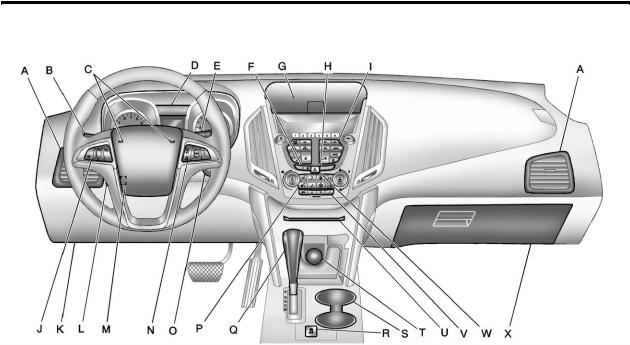
1-2 In Brief
Instrument Panel

In Brief |
1-3 |
A.Air Vents on page 8 5.
B.Turn and Lane Change Lever. See Turn and Lane-Change Signals on page 6 3.
Exterior Lamp Controls on page 6 1.
Fog Lamps on page 6 3.
C.Horn on page 5 3.
D.Instrument Cluster on page 5 9.
E.Windshield Wiper/Washer on page 5 3.
Rear Window Wiper/Washer on page 5 4.
F.Power Door Locks on page 2 7.
G.Instrument Panel Storage on page 4 1.
H.Safety Locks on page 2 8.
I.AM-FM Radio on page 7 11.
J.Cruise Control on page 9 44.
K.Data Link Connector (DLC) (Out of view). See Malfunction Indicator Lamp on page 5 14.
L.Instrument Panel Illumination Control on page 6 4.
M.Steering Wheel Adjustment on page 5 2.
N.Steering Wheel Controls on page 5 2.
O.Ignition Positions on page 9 28.
P.Climate Control Systems on page 8 1 (If Equipped).
Automatic Climate Control System on page 8 3
(If Equipped).
Q.Shift Lever. See Automatic Transmission on page 9 35.
R.StabiliTrak® System on page 9 43.
S.Cupholders on page 4 1.
T.Power Outlets on page 5 7.
U.CD Player Slot. See CD Player on page 7 19.
V.Driver Information Center (DIC) Buttons. See Driver Information Center (DIC) on page 5 22.
W.Hazard Warning Flashers on page 6 3.
X.Glove Box on page 4 1.

1-4 In Brief
Initial Drive
Information
This section provides a brief overview about some of the important features that may or may not be on your specific vehicle.
For more detailed information, refer to each of the features which can be found later in this owner manual.
Remote Keyless Entry
(RKE) System
The Remote Keyless Entry (RKE) transmitter will work up to
60 m (195 ft) away from the vehicle.
Press this button to extend the key. The key can be used for the ignition and all locks.
K : Press to unlock the driver door or all doors.
Q : Press to lock all doors.
Lock and unlock feedback can be personalized.
V: For vehicles with the power liftgate, press and hold until the liftgate begins to move to open the liftgate.
For vehicles without the power liftgate, first press K, then press and hold V to unlock the liftgate.
7 : Press and release to locate the vehicle. Press and hold for at least two seconds to sound the panic
alarm. Press 7 again to cancel the panic alarm.
See Keys on page 2 2 and Remote Keyless Entry (RKE) System Operation on page 2 3.
Remote Vehicle Start
With this feature the engine can be started from outside of the vehicle.
Starting the Vehicle
1.Press Q on the Remote Keyless Entry transmitter.
2.Press and hold / for about two seconds. The turn signal lamps will briefly flash to confirm the vehicle has been started.
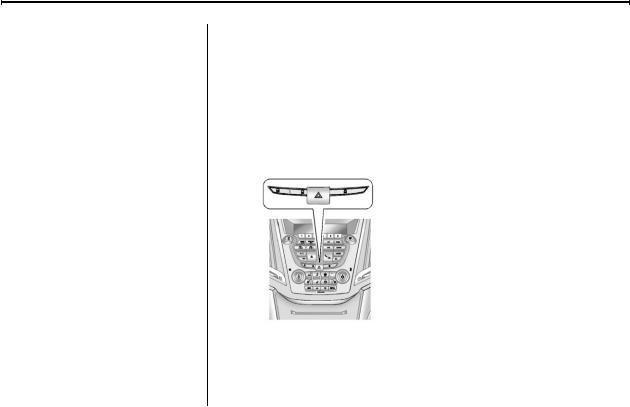
In Brief |
1-5 |
The parking lamps will turn on and remain on as long as the engine is running. The vehicle's doors will be locked.
3.The key must be inserted and turned to ON/RUN before driving.
The engine will shut off after
10 minutes unless a time extension is done or the key is inserted and turned to ON/RUN.
Canceling a Remote Start
To cancel a remote start, do one of the following:
.Press / until the parking lamps turn off.
.Turn on the hazard warning flashers.
.Insert the key and turn it to ON/RUN and then back to LOCK/OFF.
See Remote Vehicle Start on page 2 5.
Door Locks
To lock or unlock a door, use the Remote Keyless Entry (RKE) transmitter from outside the vehicle.
From inside the vehicle with the doors locked, pull once on the door handle to unlock it, and a second time to open it or use the power door lock switch.
The power door lock switches are on the instrument panel.
K : Press to unlock the doors.
Q : Press to lock the doors. See Door Locks on page 2 6.
{ : Press for Safety Locks. See Safety Locks on page 2 8.
Liftgate
Manual Liftgate Operation
Unlock the vehicle before opening the liftgate.
Press the touchpad located in the handle of the liftgate, above the license plate, and lift up to open.
Do not press the touchpad while closing the liftgate. This will cause the liftgate to be unlatched.
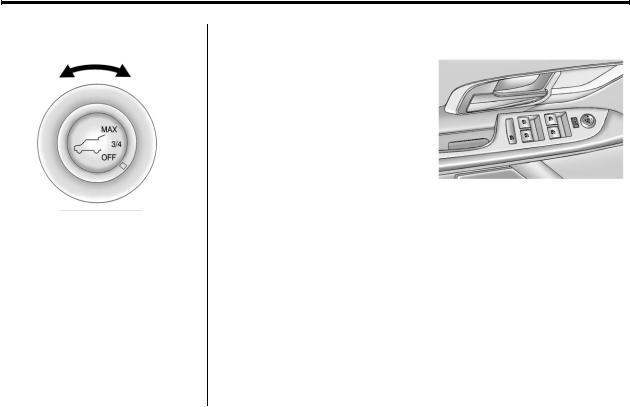
1-6 In Brief
Power Liftgate Operation
On vehicles with a power liftgate, the switch is on the overhead console. The vehicle must be in P (Park) to use the power feature.
The taillamps flash when the power liftgate moves.
Notice: If you open the liftgate without checking for overhead obstructions such as a garage door, you could damage the liftgate or the liftgate glass. Always check to make sure the area above and behind the liftgate is clear before opening it.
Choose the power liftgate mode by turning the dial on the switch to either the 3/4 or MAX position. Press the button to open or close the liftgate.
See Liftgate (Manual) on page 2 8 or Liftgate (Power) on page 2 9.
Windows
The power window controls are on each of the side doors.
The driver door also has switches that control the passenger and rear windows.
Operate the switch for the window by pressing to open and pulling to close.
Pushing or pulling the switch part of the way will open or close the window as long as the switch is operated.
See Power Windows on page 2 17.

In Brief |
1-7 |
Seat Adjustment |
Eight Way Power Driver Seat |
Lumbar Adjustment |
Four Way Power Driver Seat
To adjust the seat:
.Move the seat forward or rearward using the handle under the front of the seat cushion (A). See Seat Adjustment on
page 3 3.
.Raise or lower the entire seat by moving the control (B) up or down.
See Power Seat Adjustment on page 3 3 for more information.
To adjust a power seat, if equipped:
.Move the seat forward or rearward by sliding the control forward or rearward.
.Raise or lower the front or rear part of the seat cushion by moving the front or rear of the control up or down.
.Raise or lower the entire seat by moving the entire control up or down.
See Power Seat Adjustment on page 3 3 for more information.
Eight-Way Power Seat Shown,
Four-Way Similar
If available, press and hold the front or rear of the switch (A) to increase or decrease lumbar support. Release the control when the seatback reaches the desired level of lumbar support.
See Lumbar Adjustment on page 3 6 for more information.
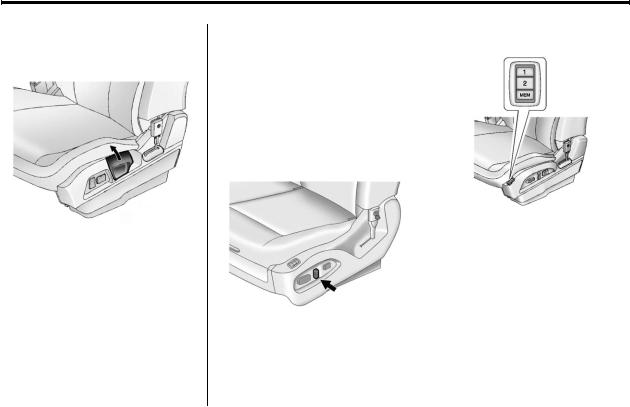
1-8 In Brief
Reclining Seatbacks
Manual Reclining Seatbacks
To recline a manual seatback:
1.Lift the lever.
2.Move the seatback to the desired position, and then release the lever to lock the seatback in place.
3.Push and pull on the seatback to make sure it is locked.
To return the seatback to the upright position:
1.Lift the lever fully without applying pressure to the seatback, and the seatback will return to the upright position.
2.Push and pull on the seatback to make sure it is locked.
Power Reclining Seatbacks
To adjust a power seatback, if available:
.Tilt the top of the control rearward to recline.
.Tilt the top of the control forward to raise.
Memory Features
On vehicles with the memory feature, the “1” and “2” buttons on the outboard side of the driver seat are used to manually save and recall the driver seat and outside mirror positions. These manually stored positions are referred to as Button Memory positions.

In Brief |
1-9 |
The vehicle will also automatically save driver seat and outside mirror positions to the current driver Remote Keyless Entry (RKE) transmitter when the ignition is turned off. These automatically stored positions are referred to as RKE Memory positions.
Storing Button Memory Positions
To save positions into Button Memory:
1.Adjust the driver seat, seatback recliner, and both outside mirrors to the desired driving positions.
2.Press and release the MEM (Memory) button.
3.Press “1” until a beep sounds.
4.Repeat Steps 1 through 3 for a second driver using “2.”
To recall the manually saved Button Memory positions, press and hold “1” or “2.” The driver seat and outside mirrors move to the positions stored to those buttons when pressed. Releasing “1” or “2” before the stored positions are reached stops the recall.
To automatically recall RKE Memory positions, unlock the driver door with the RKE transmitter and open the driver door. If the driver door is already open, pressing the RKE transmitter K button will also activate the RKE Memory recall. The driver seat and outside mirrors will move to the previously saved RKE Memory positions.
See “Memory Seat and Mirrors” under Power Seat Adjustment on page 3 3 for more information.
Easy Exit Driver Seat
This feature moves the seat rearward allowing the driver more room to exit the vehicle.
To activate, turn the ignition off and open the driver door. If the driver door is already open, turning the ignition off will activate the easy exit driver seat.
This feature can be turned on or off using the vehicle personalization menu. See “Easy Exit Driver Seat” under Vehicle Personalization on page 5 32 for more information.

1-10 |
In Brief |
Heated Seats
On vehicles with heated front seats, the buttons are near the climate controls. To operate, the ignition must be in ON/RUN.
Press L or M to heat the driver or passenger seat cushion and seatback.
Indicator lights on the button show the temperature setting.
See Heated Front Seats on page 3 9.
Head Restraint
Adjustment
Do not drive until the head restraints for all occupants are installed and adjusted properly.
To achieve a comfortable seating position, change the seatback recline angle as little as necessary while keeping the seat and the head restraint height in the proper position.
For more information see Head Restraints on page 3 2 and Seat Adjustment on page 3 3.
Safety Belts
Refer to the following sections for important information on how to use safety belts properly.
.Safety Belts on page 3 11.
.How to Wear Safety Belts Properly on page 3 15.
.Lap-Shoulder Belt on page 3 20.
.Lower Anchors and Tethers for Children (LATCH System) on page 3 52.

In Brief |
1-11 |
Sensing System for Passenger Airbag
United States
Canada
The passenger sensing system will turn off the right front passenger frontal airbag under certain conditions. The driver airbag, seat mounted side impact airbags, and roof rail airbags are not affected by the passenger sensing system.
The passenger airbag status indicator will be visible on the overhead console when the vehicle is started. See Passenger Sensing System on page 3 35 for more information.
Mirror Adjustment
Exterior
Controls for the outside power mirrors are on the driver door.
To adjust the mirrors:
1.Move the selector switch to
L (left) or R (right) to choose the driver or passenger mirror.
2.Press the arrows on the control pad to move each mirror in the desired direction.
3.Return the selector switch to the middle position.
See Power Mirrors on page 2 15.
Interior
Vehicles with an automatic dimming inside rearview mirror can automatically reduce the glare from the headlamps of the vehicle behind you. The dimming feature comes on and the indicator light comes on each time the vehicle is started.
See Automatic Dimming Rearview Mirror on page 2 16.

1-12 |
In Brief |
Steering Wheel
Adjustment
To adjust the steering wheel:
1.Pull the lever (A) down.
2.Move the steering wheel up or down.
3.Pull or push the steering wheel closer or away from you.
4.Pull the lever (A) up to lock the steering wheel in place.
Do not adjust the steering wheel while driving.
Interior Lighting
Reading Lamps
These lamps are located on the overhead console. These lamps come on automatically when any door is opened.
For manual operation, press the button next to each lamp to turn it on or off.
Center Dome Lamps
There are front and rear dome lamps.
The dome lamp controls are located in the overhead console. To change the settings, press the following:
* : Turns the lamp off, even when a door is open.
1 : The lamps come on automatically when a door is opened.
+ : Turns the dome lamps on.
The dome lamps can also be turned on and off by pressing the buttons next to the lamps.
For more information on interior lighting, See Instrument Panel Illumination Control on page 6 4.
Exterior Lighting
The exterior lamp control is located on the turn signal/lane change lever.
O : Turn to operate the exterior lamps.
O : Turns the exterior lamps off.

In Brief |
1-13 |
AUTO: Turns the exterior lamps on and off automatically depending on the exterior light.
; : Turns on the parking lamps, together with the sidemarker lamps, taillamps, license plate lamps, and instrument panel lights.
5 : Turns on the headlamps, together with the parking lamps, sidemarker lamps, taillamps, license plate lamps, and instrument panel lights.
For more information, see:
.Exterior Lamp Controls on page 6 1.
.Daytime Running Lamps (DRL) on page 6 2.
.Fog Lamps on page 6 3.
Windshield Wiper/Washer
The windshield wiper/washer lever is located on the right side of the steering column.
Move the lever to one of the following positions:
8 : Single wipe, move the lever to 8 and then release. The wipers stop after one wipe.
( : Turns the wipers off.
& : Adjusts the time between wipes. Turn the & band up for more frequent wipes or down for less frequent wipes.
1:Slow wipes.
2:Fast wipes.
Windshield Washer
Pull the lever toward you to spray washer fluid on the windshield. The spray continues until the lever is released.
Rear Window Wiper/Washer
The rear wiper controls are on the end of the windshield wiper lever.
Press the upper or lower portion of the button to control the rear wiper and rear wiper delay.
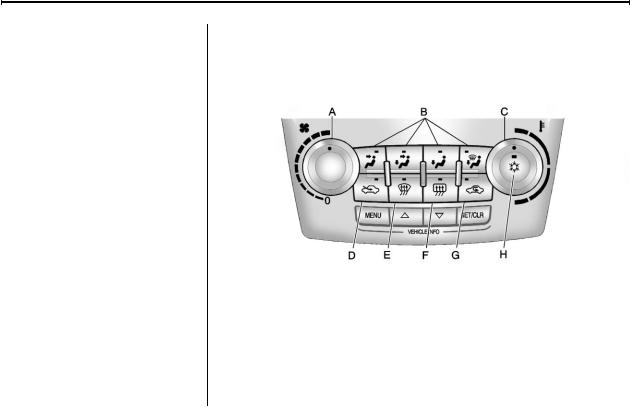
1-14 |
In Brief |
The system turns off when the button is returned to the middle position.
Z : For continuous rear window wipes.
5 : To set a delay between wipes.
= : Push the windshield wiper lever forward to spray washer fluid on the rear window. The lever returns to its starting position when released.
See Windshield Wiper/Washer on page 5 3 and Rear Window Wiper/Washer on page 5 4.
Climate Controls
The vehicle's heating, cooling, defrosting, and ventilation can be controlled with these systems.
Climate Control System
A. |
Fan Control |
E. |
Defrost |
B. |
Air Delivery Mode Controls |
F. |
Rear Window Defogger |
C. |
Temperature Control |
G. |
Recirculation |
D. |
Outside Air |
H. |
Air Conditioning |

In Brief |
1-15 |
Automatic Climate Control System |
Parking Brake |
A.Fan Control
B.AUTO (Automatic Operation)
C.Air Delivery Mode Controls
D.Defrost
E.Recirculation
F.Temperature Control
G.Power
H.Driver and Passenger Heated Seats
I.Rear Window Defogger
J.Air Conditioning
See Climate Control Systems on page 8 1 (If Equipped) or Automatic Climate Control System on page 8 3
(If Equipped).
To set the parking brake, hold the regular brake pedal down, then push the parking brake pedal down.
If the ignition is on, the brake system warning light will come on. See Brake System Warning Light on page 5 16.
To release the parking brake, hold the regular brake pedal down, then push down momentarily on the parking brake pedal until you feel the pedal release. Slowly pull your foot up off the park brake pedal. See Parking Brake on page 9 40.
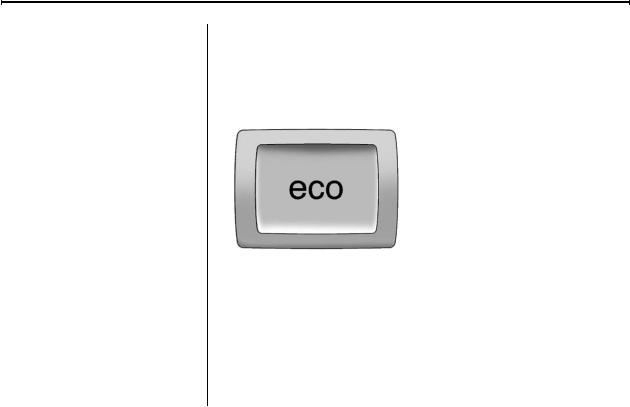
1-16 |
In Brief |
Transmission
Electronic Range Select
(ERS) Mode
ERS or manual mode allows for the selection of the range of gear positions. Use this mode when driving down hill or towing a trailer to limit the top gear and vehicle speed.
To use this feature:
1.Move the shift lever to M (Manual Mode).
2.Press the plus/minus button on the shift lever, to increase or decrease the gear range available.
See Manual Mode on page 9 37 for more information.
Fuel Economy Mode
Vehicles with a 2.4L engine have a Fuel Economy Mode. When engaged, fuel economy mode can
improve the vehicle's fuel economy.
Press the “eco” (economy) button by the shift lever to turn this feature on or off. The “eco” light in the instrument cluster will come on when engaged, and a Driver Information Center (DIC) message “ECO MODE ON” displays. See
Fuel Economy Mode on page 9 38.
Vehicle Features
Radio(s)
VOL/ O : Press to turn the system on and off. Turn to increase or decrease the volume.
RADIO/BAND: Press to choose between FM, AM, or XM™,
if equipped.
TUNE/INFO: Turn to select radio stations.
Press to show available information about the current station or track.
g SEEK: Press to seek the previous station or track.
l SEEK: Press to seek the next station or track.
Buttons 1 6: Press to save and select favorite stations
For more information about these and other radio features, see
Operation on page 7 7.

In Brief |
1-17 |
For more information about the Rear Seat Entertainment (RSE) System, see Rear Seat Entertainment (RSE) System on page 7 33.
For more information about the Rear Seat Audio (RSA) System, see Rear Seat Audio (RSA) System on
page 7 43.
Storing a Favorite Station
Stations from all bands can be stored in the favorite lists in any order. Up to six stations can be stored in each favorite page and the number of available favorite pages can be set.
To store the station to a position in the list, press the corresponding numeric button 1-6 until the station can be heard again.
For more information, see “Storing and Retrieving Favorites” in AM-FM Radio on page 7 11.
Setting the Clock
The vehicle has a digital and an analog clock.
For detailed instructions on setting either clock, see Clock (With Date Display) on page 5 5 or Clock (Without Date Display) on page 5 6.
Turning the Digital Clock On or Off
1.Press the CONFIG button.
2.Select Time and Date Settings.
3.Select Clock Displayed.
4.Press the MENU/SELECT button to turn the clock on or off.
Setting the Time and Date
1.Press the CONFIG button.
2.Select Time and Date Settings.
3.Select Set Time or Set Date.
4.Turn the MENU/SELECT knob to adjust the highlighted value.
5.Press the MENU/SELECT knob to select the next value.
6.To save the time or date and return to the Time and Date Settings menu, press the BACK 0 button at any time or press the MENU/SELECT knob after adjusting the minutes
or year.
Setting the 12/24 Hour Format
1.Press the CONFIG button.
2.Select Time and Date Settings.
3.Highlight 12/24 Hour Format.
4.Press the MENU/SELECT button to select the 12 hour or 24 hour display format.

1-18 |
In Brief |
Setting the Month & Day Format
1.Press the CONFIG button.
2.Select Time and Date Settings.
3.Highlight Month & Day Format.
4.Press the MENU/SELECT knob to select MM/DD (month/day) or DD/MM (day/month).
Setting the Auto Time Adjust
1.Press the CONFIG button.
2.Select Time and Date Settings.
3.Highlight Auto Time Adjust.
4.Press the MENU/SELECT knob to turn Auto Time Adjust on
or off.
Satellite Radio
Vehicles with an XM™ Satellite Radio tuner and a valid XM Satellite Radio subscription can receive
XM programming.
XM Satellite Radio Service
XM is a satellite radio service based in the 48 contiguous United States and 10 Canadian provinces.
XM Satellite Radio has a wide variety of programming and commercial-free music, coast to coast, and in digital-quality sound. A fee is required to receive the XM service.
For more information refer to:
.www.xmradio.com or call 1-800-929-2100 (U.S.).
.www.xmradio.ca or call 1-877-438-9677 (Canada).
For more information, see Satellite Radio on page 7 14.
Portable Audio Devices
This vehicle may have a 3.5 mm (1/8 in) auxiliary input and a USB port located in the center console. External devices such as iPods®, laptop computers, MP3 players, CD changers, and USB storage devices may be connected, depending on the audio system.
For more information, see Auxiliary Devices (Radio with CD) on
page 7 28 or Auxiliary Devices (Radio with CD/DVD/MEM) on page 7 31.

In Brief |
1-19 |
Bluetooth®
The Bluetooth® system allows users with a Bluetooth-enabled cell phone to make and receive hands-free calls using the vehicle audio system, microphone, and controls.
The Bluetooth-enabled cell phone must be paired with the in-vehicle Bluetooth system before it can be used in the vehicle. Not all phones will support all functions.
See Bluetooth (Overview) on page 7 46 or Bluetooth (Infotainment Controls) on page 7 47 or Bluetooth (Voice Recognition) on page 7 51.
Steering Wheel Controls
Some audio steering wheel controls can be adjusted at the steering wheel.
b g : Press to interact with the available Bluetooth or OnStar systems.
$ i : Press to silence the vehicle speakers only. Press again to turn the sound on. For vehicles with OnStar or Bluetooth systems, press to reject an incoming call, or end a current call.
_ SRC ^ : Press to select an audio source.
Toggle up or down to select the next or previous favorite radio station, CD, or MP3 track.
+ x − : Press + to increase the volume; press − to decrease the volume.
For more information, see Steering Wheel Controls on page 5 2.

1-20 |
In Brief |
Cruise Control
5 : Press to turn the cruise control system on and off.
\ : Press to disengage cruise control without erasing the set speed from memory.
RES/+ : Move the thumbwheel up to make the vehicle resume to
a previously set speed or to accelerate.
SET/− : Move the thumbwheel down toward SET/- to set a speed and activate cruise control, or to make the vehicle decelerate.
See Cruise Control on page 9 44.
Navigation System
The vehicle's navigation system
(if equipped) provides detailed maps of most major freeways and roads. After a destination has been set, the system provides turn-by-turn instructions for reaching the destination. In addition, the system can help locate a variety of points of interest (POI), such as banks, airports, restaurants, and more.
See the Navigation System manual for more information.
Driver Information
Center (DIC)
The DIC display is located in the center of the instrument panel cluster. It shows the status of many vehicle systems.
The DIC buttons are located below the climate control system.

In Brief |
1-21 |
MENU: Press this button to get to the Trip/Fuel Menu and the Vehicle Information Menu.
w x : Use these buttons to scroll through the items in each menu.
A small marker will move along the page as you scroll through the items. This shows where each page is in the menu.
SET/CLR: Use this button to set or clear the menu item when it is displayed.
For more information, see Driver Information Center (DIC) on page 5 22.
Vehicle Personalization
Some vehicle features can be programmed by using the audio system controls. These features include:
.Climate and Air Quality
.Comfort and Convenience
.Collision/Detection Systems
.Language
.Lighting
.Power Door Locks
.Remote Lock/Unlock/Start
.Return to Factory Settings
See Vehicle Personalization on page 5 32.
Rear Vision
Camera (RVC)
If available, the rear vision camera displays a view of the area behind the vehicle when the vehicle is shifted into R (Reverse). The display will appear on either the inside rearview mirror or navigation screen, if equipped.
To clean the camera lens, located above the license plate, rinse it with water and wipe it with a soft cloth.
See Rear Vision Camera (RVC) on page 9 48.

1-22 |
In Brief |
Ultrasonic Parking Assist
If available, Ultrasonic Rear Parking Assist (URPA) uses sensors on the rear bumper to detect objects while parking the vehicle. URPA comes on automatically when the shift lever is moved into R (Reverse) and operates at speeds less than 8 km/h (5 mph). URPA uses audio beeps
to provide distance and system information.
Keep the sensors on the vehicle's rear bumper clean to ensure proper operation.
The URPA system can be turned on and off using the infotainment system controls. See Vehicle Personalization on page 5 32 for more information.
See Ultrasonic Parking Assist on page 9 46 for more information.
Roof Rack System
The roof rack cross rails can be locked in four positions along the roof rack side rails. Lift the lever to release and move the cross rail. Push the lever down to completely engage into the side rail holes. Slide the cross rails back and forth until the lock pins engage in the holes and a click is heard.
When the roof rack is not in use, lock one cross rail at the furthest forward position and lock the other cross rail at the furthest rearward position to reduce wind noise. See Roof Rack System on
page 4 2.
Power Outlets
The accessory power outlets can be used to connect electrical equipment, such as a cell phone or MP3 player.
There are four accessory power outlets in the following locations: below the CD slot, inside the center console storage, on the rear of the center console storage, and in the rear cargo compartment.
To use the outlets, remove the cover and close when not in use.
See Power Outlets on page 5 7.

In Brief |
1-23 |
Performance and
Maintenance
Traction Control
System (TCS)
The traction control system limits wheel spin. The system is on when the vehicle is started.
.To turn off traction control, press and release g located on the console. i illuminates and the appropriate DIC message displays. See Vehicle Messages on page 5 25.
.Press and release g again to turn traction control back on.
For more information, see Traction Control System (TCS) on
page 9 41.
StabiliTrak® System
The StabiliTrak system assists with directional control of the
vehicle in difficult driving conditions. The system is on when the vehicle is started.
.To turn off both Traction Control and StabiliTrak, press and
hold g until g and i illuminate and the appropriate DIC message displays. See Vehicle Messages on page 5 25.
.Press g again to turn on both systems.
For more information, see
StabiliTrak® System on page 9 43.
Tire Pressure Monitor
This vehicle may have a Tire Pressure Monitor System (TPMS).
The TPMS warning light alerts you to a significant loss in pressure of one of the vehicle's tires. If the warning light comes on, stop as soon as possible and inflate the tires to the recommended pressure shown on the Tire and Loading Information label. See Vehicle Load Limits on page 9 22. The warning light will remain on until the tire pressure is corrected.

1-24 |
In Brief |
During cooler conditions, the low tire pressure warning light may appear when the vehicle is first started and then turn off. This may be an early indicator that the tire pressures are getting low and the tires need to be inflated to the proper pressure.
The TPMS does not replace normal monthly tire maintenance. It is the driver’s responsibility to maintain correct tire pressures.
See Tire Pressure Monitor System on page 10 56.
Engine Oil Life System
The engine oil life system calculates engine oil life based on vehicle use and displays the CHANGE ENGINE OIL SOON message when it is time to change the engine oil and filter.
The oil life system should be reset to 100% only following an oil change.
Resetting the Oil Life System
1.Turn the ignition to ON/RUN, with the engine off.
2.Press the DIC menu button to display the Vehicle Information menu.
3.Press either the up or down arrows to view REMAINING OIL LIFE.
4.Press the SET/CLR button until 100% is displayed.
5.Turn the key to LOCK/OFF.
Or:
1.Turn the ignition to ON/RUN with the engine off.
2.Fully press and release the accelerator pedal three times within five seconds.
See Engine Oil Life System on page 10 14.
Fuel E85 (85% Ethanol)
Vehicles that have a FlexFuel badge and a yellow fuel cap can use either unleaded gasoline or ethanol fuel containing up to 85% ethanol (E85). See Fuel E85 (85% Ethanol) on page 9 56. For all other vehicles, use only the unleaded gasoline described under Recommended Fuel on page 9 53.
Driving for Better Fuel Economy
Driving habits can affect fuel mileage. Here are some driving tips to get the best fuel economy possible.
.Avoid fast starts and accelerate smoothly.
.Brake gradually and avoid abrupt stops.
